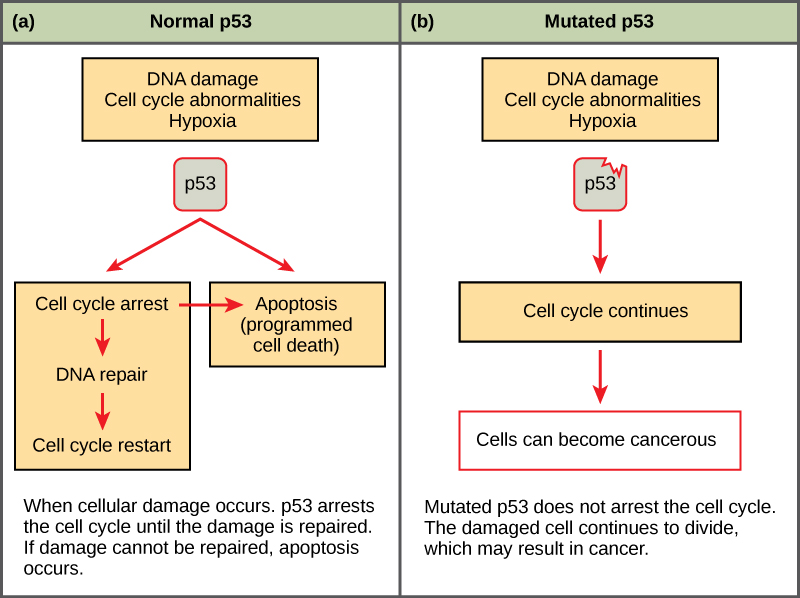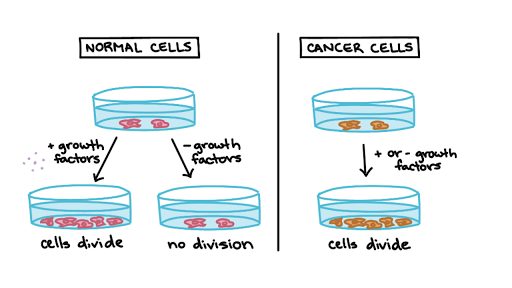Best Describes the Development of Cancer
Commonest Carcinogens which are known to be responsible for the development of cancer include tobacco alcohol fast food carbonated drinks exposure to UV rays from the sun viruses such as Hepatitis B and C human papilloma virus genetic causative agents and positive family history. When the client has been in remission for 2 years.

6 3 Cancer And The Cell Cycle Concepts Of Biology 1st Canadian Edition
The growth and spread of abnormal cells in the body a type of communicable disease development of indigenous cells in the body the growth and spread of healthy cells in the body.

. Certain gene changes can cause cells to evade normal growth controls and become cancer. The presence of tumor suppressor genes increases the risk for gene damage by environmental carcinogens. Chewing tobacco has been linked to cancer of the oral cavity and.
Although cancer can develop in virtually any of the bodys tissues and each type of cancer has its unique features the basic processes that produce cancer are quite similar in all forms of the disease. Cancer cells has the ability to spread from one organ to another via the circulatory system. Rudolph Virchow identifies white blood cells leukocytes in cancerous tissue making the first connection between inflammation and cancer.
Smoking has been linked to various types of cancer including cancer of the lung mouth throat larynx pancreas bladder cervix and kidney. These cells can form in any organ of the body. Read more Initiation.
Approved by the CancerNet Editorial Board 022021. The presence of tumor suppressor genes increases the risk for gene damage by environmental carcinogens. The first step in cancer development is initiation in which a change in a cells genetic material a mutation primes the cell to become cancerous.
This property of cancer is called metastasis. This stage is also known as stage 0. M describes whether the cancer has spread to a different part of the body.
Tumor suppressor genes control or modify the activity of oncogenes reducing the risk for cancer development. The fundamental abnormality resulting in the development of cancer is the continual unregulated proliferation of cancer cells. Virchow also coins the term leukemia and is the first person to describe the excess number of white blood cells in the blood of patients with this disease.
Cancer often has the ability to spread throughout your body. T refers to the size of the cancer and how far it has spread into nearby tissue it can be 1 2 3 or 4 with 1 being small and 4 large. Which of the following best describes cancer.
Cancer cells undergo cell division without stopping thus leading to the development of cancerous tissues. The system uses letters and numbers to describe the cancer. Cancer development happens in multiple stages from precancerous changes to malignant tumors.
If this initial phase is not taken into consideration then the development is described in 3 stages. Rather than responding appropriately to the signals that control normal cell behavior cancer cells grow and divide in an uncontrolled manner invading normal tissues and organs. The oncology nurse is discussing the concept of survivorship with a client with cancer.
Before starting any cancer treatment doctors may use physical exams imaging scans. Question 4 of 10. Blood cancers such as leukaemias or lymphomas behave differently and are described in different ways.
Which of the following best describes cancer. Which statement best describes the role of tumor suppressor genes in cancer development. Many causes are responsible for the formation of cancer.
Which of the following correctly describes when survivorship begins. Sometimes the stages are further subdivided into sub-stages like stage 2A 2B or 3A 3B etc. When a client receives the last dose of chemotherapy.
N describes whether there are any cancer cells in the lymph nodes. In simple terms cancer is a group of more than 100 diseases that develop across time and involve the uncontrolled division of the bodys cells. Using any type of tobacco puts you on a collision course with cancer.
The Development and Causes of Cancer - The Cell - NCBI Bookshelf. Genes carry the instructions to make proteins which do much of the work in our cells. Stages are used to describe the spread of solid tumours like breast bowel or lung cancers.
However not all cancers form tumors and different cancers can develop at different rates. Cancer is a genetic diseasethat is cancer is caused by certain changes to genes that control the way our cells function especially how they grow and divide. The growth and spread of abnormal cells in the body a type of communicable disease development of.
The stage of a cancer describes how far the cancer has grown and spread at the time of diagnosis. Cancer refers to any one of a large number of diseases characterized by the development of abnormal cells that divide uncontrollably and have the ability to infiltrate and destroy normal body tissue. The cancers stage tells you where a cancer is located and its size how far it has grown into nearby tissues and if it has spread to nearby lymph nodes or other parts of the body.
Tumor suppressor genes control or modify the activity of oncogenes reducing the risk for cancer development. Here we are going to discuss 4 stages of the development of cancer. The change in the cells genetic material may occur spontaneously or be brought.
Which statement best describes the role of tumor suppressor genes in cancer development. When a clients PET scan is negative. Cancer begins when cells acquire the ability to grow uncontrollably and ultimately invade and damage the bodys normal tissues.
Staging is a way to describe a cancer. Consider these cancer-prevention tips. Cancer is the second-leading cause of death in the world.

Which Popular Myers Briggs Personality Best Describes You Myers Briggs Personalities Personality Type Quiz Esfj

Cancer And The Cell Cycle Biology Article Khan Academy

Pin By Sam Renn On Zodiac Zodiac Signs Horoscope Zodiac Horoscope
No comments for "Best Describes the Development of Cancer"
Post a Comment